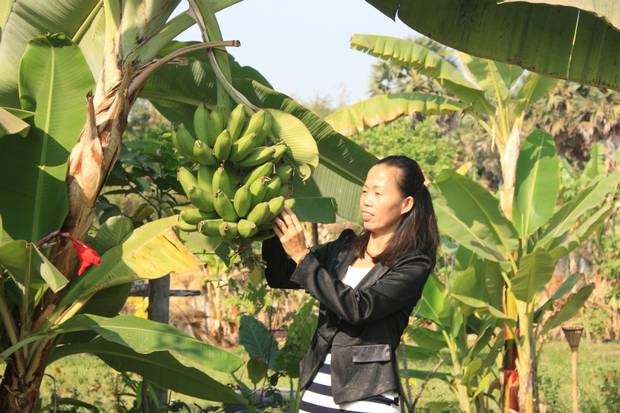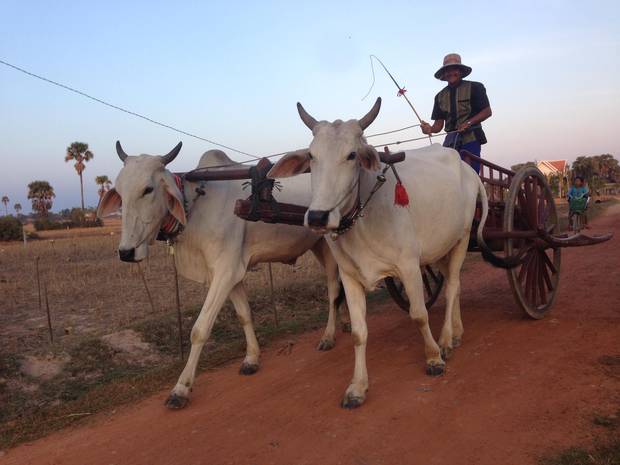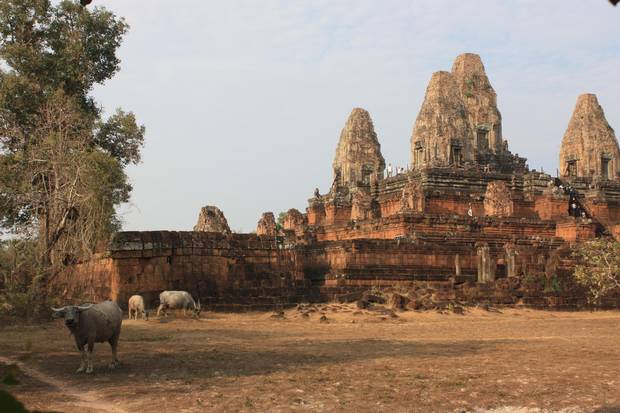In the close heat of a February afternoon in Siem Reap, my husband and I check out of our hotel and seek shade under a tree in the property's driveway. We wait, keeping an ear out for the familiar rev and cough of a three-wheeled tuk-tuk to rise above the noon-time cacophony of the narrow, shop-lined street out front; we've been told transport is on the way to take us to our next destination.
We are midway through our five-day visit to this Cambodian provincial town, the gateway to Angkor, the remains of the Khmer Empire first carved out of the hostile jungle more than a millennium ago. We've enjoyed the contrast of visiting temple ruins in the countryside and strolling through the town's charming Old French Quarter by day or touristy Pub Street by night. But having experienced a hotel in Siem Reap proper, we're ready to move to one in its outskirts – a small property of six traditional Khmer homes amid rice fields about seven kilometres away, near the village of Chrey. Not to be too uppity about it, but the bustle of the city, together with the unending arrivals of tour buses disgorging tourists so numerous they appear like colonizing ants, can make one desperate for solitude at day's end.
It can also force the fortunate traveller to confront some disquieting realities.
Tourists walk past restaurants and bars on Pub Street at night in Siem Reap.
BRENT LEWIN/Bloomberg
The archeological park of the Khmer ruins, anchored by the awe-inspiring 12th-century Angkor Wat, draws more than two million visitors a year. While the town of Siem Reap has benefited from a tourist boom, the province of Siem Reap itself remains the poorest in the country; the livelihoods or activities of most rural Cambodians rarely intersect with the tourism sector. For us, that is about to change. Our next destination, Angkor Rural Boutique Resort, is owned and run by a Cambodian woman who, by day, is a professor of sustainable tourism and ecotourism – holding out the possibility that foreign travel to a poor country can be at once self-indulgent and socially responsible.
Instead of a tuk-tuk, a grey Toyota Camry pulls up. The driver's door opens and red patent high heels reach for the gravel. Sokun Ang, the owner herself, is our driver. She swishes her straight black hair over her slight shoulders, hefts our bags into the trunk and we're on our way out of town, joining the constant stream of traffic on National Highway 6.
Fifteen minutes later, Ang turns off onto a dirt road. It narrows to one lane, hued red by laterite soil and rock and, where sand has accumulated, marked by scooter and bicycle tracks. A few hundred metres on, a white ox grazes across from the Angkor Rural Boutique Resort. Mere steps from that is reception, where Sophika Souy, a pretty 20 year old with an easy smile, greets us with a cold drink and towel. Ang herself walks us to our bungalow.

Sokun Ang envisioned Angkor Rural Boutique Resort as a place where guests could join in activities to assist elderly villagers.
DENISE CHONG/For The Globe and Mail
Everything about the hotel is intimate. The outdoor reception and dining area and its deck above for massages nestles beside the organic fruit and vegetable garden, over which a scarecrow stands guard. The cultivated areas of the property meander around four bungalows placed at close quarters – even a ditch-like depression between two more rear huts has plantings – and hug a fence separating the resort from a villager's fields. Five months into the dry season, the field is a brown expanse, the luminous green of rice plants left to the imagination.
The sun hangs high in the sky and only an occasional breath of wind whispers through the banana plants that provide privacy around the deck of our bungalow. A sunken bath has been filled, timed for our arrival, the cool water scattered with yellow frangipani petals. Instead, we seek out the pool, which is unlike any I have seen. Except where its surface mirrors poolside palms, its dark-grey slate colour gives it the appearance of a rectangle that's been cut out from a river.
But Angkor Rural Boutique Resort is about much more than appearances. Five years ago, Ang, a tall, reed-thin woman whose heels click with brisk authority, was assigned to teach a new course in ecotourism and sustainable development at the Siem Reap campus of a private Cambodian university. She searched the Internet and while she could find examples of such ventures abroad, she found none in Cambodia. "Why not start my own ecohotel?" she thought.

Poolside at the Angkor Rural Boutique Resort, an ecotourism and sustainable development project near Siem Reap, Cambodia.
DENISE CHONG/For The Globe and Mail
For Ang, a 38-year-old mother of three young children, such a project was as much necessity as personal ambition. In an economy crippled by the corruption and graft rife within the government of Hun Sen, who has kept a grip on power since 1985, it's a constant struggle for most Cambodians to maintain their standard of living. Salaries in the public sector are below a living wage. Spending in education, health and rural development – sectors neglected by government if only because better opportunities exist elsewhere to skim off funds – relies on international donor funding. Even though her husband holds down two jobs – at the provincial government and teaching at the university – she needed to bring in extra money.
Ang purchased farmland in Chrey village ("There's a friendliness and honesty that you can't find in the city"). Initially, she had in mind an NGO-sponsored hotel. She envisaged guests joining in activities to assist elderly villagers left without children to support them either because of the toll of HIV/AIDS, which Ang had seen first-hand in volunteer work for an NGO, or because they were among the nearly two million – a fifth of the country's population – who lost their lives or were murdered by the Khmer Rouge when it held power from 1975 to 1979. (No Cambodian is untouched by the brutal genocide; the entire family of one of Ang's aunts, including four young children, was executed.)
She pitched NGOs, but with no takers she decided to go it alone. Ang used her limited funds to "rescue" a traditional Khmer wood house in Siem Reap, one slated for demolition to make way for tourism development. Workers methodically dismantled the house, down to the latches on the doors and windows, and reassembled it in Chrey as a guest house. It was modified only to guard against mould and keep out mice and insects. An aunt of Ang's, impressed by her niece's enterprising ways – as a young child she cultivated morning glory spinach on the banks of the Mekong River to go with the extra fish her father would sometimes catch in their family's trap – stepped in as financier, funding three more house "rescues." Ang also erected two new bungalows, and in place of scarce timber used traditional palm and bamboo cladding.

Chrey is a small village near the city Siem Reap, a base used by tourists to visit the region’s historic temples. With her boutique hotel near Chrey, entrepreneur Sokun Ang is plugging villagers in to the tourism industry.
DENISE CHONG/For The Globe and Mail
After taking in the hotel's free ox-cart ride around Chrey village, my husband and I take advantage of the bicycles available for guests to do another circuit. The village's couple dozen houses, each neatly delineated by a high stack of hay for the family's ox, rim a circular road. The popularity of cement, painted various colours, as the preferred building material explains the locals' early bewilderment at the hotelier in their midst, busy reassembling weathered timber homes. Gossip came back to Ang: "She must be so poor!"
"Hello! Bye! Where you go?" Children call out to us as we ride by, their English perhaps learned from Chetra Kong, a staff member whom Ang assigns to give a free weekly English lesson. At the age of 24, Chetra, one of Ang's university students from Siem Reap, has better prospects than his parents; his mother peddles clothes and his father fixes bicycles. The hotel's remaining 10 staff are from the village, which, in many ways, has come to partner with Ang. Meat, fish and any shortfall in vegetables not met by the harvest from the property's gardens are sourced in the market a 10-minute walk away. Staff have been trained to maintain the filtration system that recycles grey water for the garden. They cook and clean and tend the organic garden. Come the rainy season, the staff will replace the lemongrass growing in a sculpted depression between two guest houses with rice seedlings. Explaining how an enterprise such as hers brings the poor into the market economy, Ang expresses her satisfaction: "Chrey village is prosperous because its people are hard-working."

Roluos is a small Cambodian town and an archaeological site about 13 km east of Siem Reap. Less frequented by tourists, its temples date back more than a thousand years, older than the Angkor Wat archaeological area.
DENISE CHONG/For The Globe and Mail
We have reserved our last full day for visiting the nearby lesser-visited Roluos group of temples, which, like Chrey village, date to the ninth century to pre-Angkorian times. All told, we ride for about 20 kilometres on mostly dirt roads, using a map hand drawn by Ang. The poverty of Cambodian rural life unfolds starkly: women sitting cross-legged on mats minding their family's roadside stall – allowing them to remain nearby to mind their young children – with little more for sale than overripe bananas or gasoline for passing scooters, sold in Johnny Walker whisky bottles. The women eye us without thought of a potential sale: For the rural poor, the coveted tourist dollar is real but, like the coin in a sleight of hand of a magician's trick, illusory.
Back at the resort, we manoeuvre around the white-skinned ox, again grazing at the hotel entrance, and park our bicycles. Red dust cakes our sweaty brows and coats our clothes. After a quick shower, we seek relief from the day's exertions with a swim in the pool. At first, I had been leery of its waters, mistaking its greyness for murkiness when, in fact, I was seeing through its depths to the pool's black marble edges and bottom. I learn that nature is the pool's custodian: The stone, quarried from a mountain in Vietnam, holds heat by night, and every human touch only polishes it.
The late afternoon fades to evening, and to the dinner hour. The hotel's menu is limited but we tell Souy, who does double duty receiving guests and serving at mealtimes, that we are more than happy to return to the "Unforgettable Fragrant Chicken" cooked with jackfruit and lemongrass, and fried morning glory, picked fresh from the garden.
At the end of the day, we're ready for a well-earned sleep. It is not to be; an outdoor Buddhist wedding celebration that began that morning in the village has turned raucous. Lilting tunes emanating from speakers have given way to music with a driving bass worthy of a rock concert. We express our disappointment to Ang. She goes to have a word with the bride's father, confident he'll oblige because he's a relative of the widowed mother of Souy.
Mercifully, come 11 p.m., silence falls over the village.
Alas, we're jolted awake when pounding bass blares anew. We turn on a flashlight to check the time. It's half past four in the morning. An apologetic Kong would later tell us that the bride's father had compromised twice over, including on the hour of the resumption of the music, pushing it later by a full hour. So as not to jeopardize a new couple's good luck, he explains, celebrations have to be in full swing to greet the sunrise.
It is a reminder that we are just visitors here. That travel is also about adjusting to the rhythms of local life. As it happened, the early morning wake-up call gave us one last chance to take a photograph of the first light glinting over the farmers' fields.
Special to The Globe and Mail
Suites at Angkor Rural Boutique Resort start at $150 (U.S.) and include airport transfers, WiFi and an ox-cart tour. angkorruralboutiqueresort.com